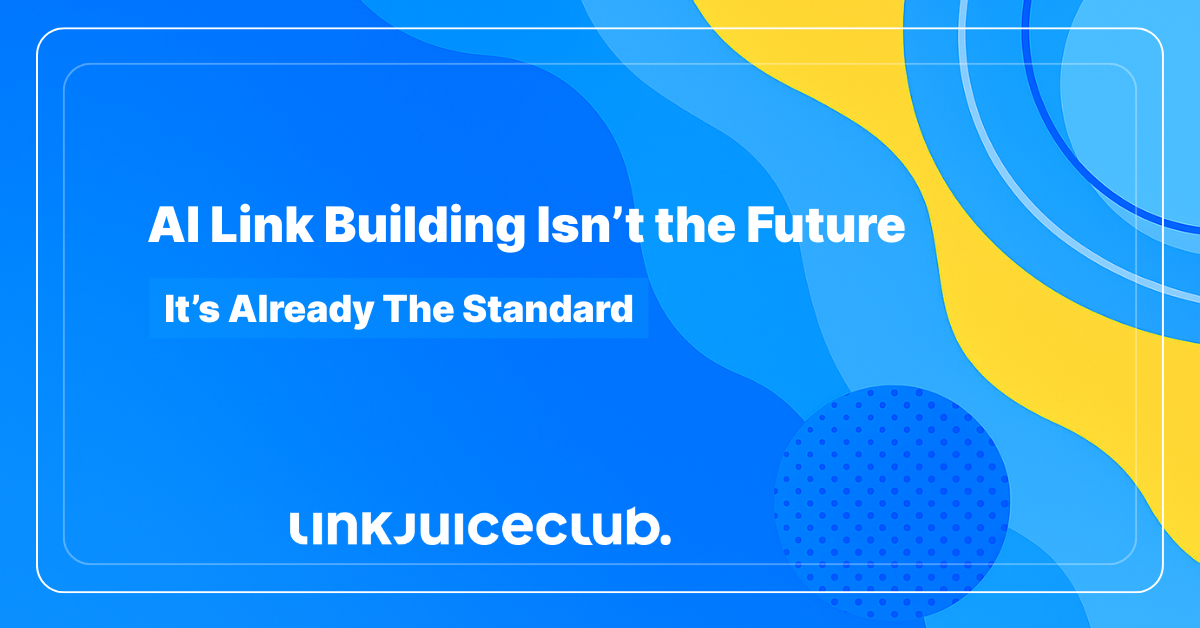
Stop Playing Catch-Up: AI Link Building Isn’t the Future; It’s Already the Standard
AI link building isn’t coming. It’s here. And most of the industry still hasn’t caught up.
Even today, you’ll see the same recycled nonsense being peddled: Use ChatGPT for topic ideas, or Let AI write your outreach emails. That’s child’s play.
This isn’t about replacing your team. It’s about cutting the busywork, supercharging your workflow, and making your link building engine run 10x harder with half the input.
When used right, AI isn’t a shortcut; it’s a multiplier. A force multiplier. One that turns ordinary SEO efforts into weapons-grade strategy.
So if you’re not already integrating AI like this, you’re:
- Drowning in manual tasks that AI could handle without breaking a sweat
- Wasting cash on cookie-cutter emails instead of running high-speed variant tests with real-time data
Let’s Get Into What Works
We’re not here to daydream. This is about what’s actually working in AI link building right now.
Tools, workflows, and prompts that bring real results, not just theory, and definitely not fluff.
If you’re ready to turn AI into the most productive hire you’ve ever made, let’s get into it. The real systems start now.

The Real Blueprint: Building Links With ChatGPT (The Right Way)
Let’s be clear: this isn’t some half-baked tools list. It’s a full-stack AI link building system, built through automation, AI augmentation, and results-first execution. Here’s how it works.
1. Find Link Prospects Using GPT + SERP Scrapes
Tired of coughing up cash for overpriced outreach platforms? You don’t need them.
ChatGPT can now handle the heavy lifting. Feed it your exported Ahrefs CSVs, SERPs, or raw HTML, and it’ll break down the data like a pro analyst on caffeine.
Trained GPTs can flag domains by DR, traffic, or topic fit. They’ll surface prospects that actually have an impact, not some random DA12 blog with three readers and a cat.
Want something deeper? Tools like Gemini can chew through massive datasets ( we’re talking 10,000+ referring domains) and still spit out insights without breaking a sweat.
2. Automate Outreach With AI That Doesn’t Suck
If you’re sending AI-generated outreach that sounds like a chatbot from 2014, stop. It’s not getting opened (let alone landing links!).
What’s the solution then? Custom GPTs trained on real personas like bloggers, affiliate site owners, etc., each with tailored tone and hooks. You rotate in fresh intros, unique angles, and real-time references scraped from live pages.
Then, plug it into Mailmeteor, Gmass, or Hunter’s API. Boom! You have hyper-personalized, scalable email sequences without the Frankenstein copywriting. ChatGPT even handles the subject line testing and can write different intros based on recent blog content or author bios!
3. Master Internal Linking With AI-Powered Precision
Everyone’s chasing shiny new backlinks, but guess what? Most of them are leaking authority like a busted pipe. Their internal linking sucks, and yours might too!
The fix? Let AI handle the architecture while you focus on scaling.
First, crawl your site. Use something like Sitebulb or Screaming Frog to grab URLs, headings, word counts, and internal link data. Feed that export to your custom GPT and give it context: which pages bring in the money, which support them, and how they’re related.
GPT doesn’t just point out problems; it builds a silo structure in seconds. It tells you which pages should feed authority to others and even throws in clean, natural anchor text suggestions.
And yes, it’ll skip the spammy stuff.
Want anchors that sound human? Ask GPT for 15 contextual variations for your keyword, like best project management software. It’ll give you real-sounding phrases like tools for team productivity, top platforms for managing remote teams, or efficient task tracking solutions. No keyword stuffing. No red flags.
4. Turn HARO Into a Link-Building Machine
Most people fail when trying to automate HARO. They scrape some queries, fire off generic answers, and hope for the best.
That’s not link building. That’s wishful thinking. Real AI link building turns HARO, Qwoted, and Help a B2B into a faucet of high-DR press mentions.
Start with your brand dossier, but expand it. Add your founder’s bio, some spicy credentials, personal stories scraped from social media, product differentiators, and links to relevant case studies. GPT needs that ammo to sound like an actual expert.
Next, automate the lead flow. Use a tool like Parsehub to scrape the HARO feed into a Google Sheet. Then hook it up with Make.com so new opportunities trigger GPT to respond in real-time. No more manual digging.
Now, tell GPT what to do. Prompt it like a seasoned PR strategist: “Generate a punchy, expert-level reply for this query, referencing the background, and include a bold quote for journalists to use directly.”
You’ll get professional, credible answers that sound like they came from a seasoned thought leader, not an AI.
Finally, shoot those responses out using Mailparser or Gmail API. Now you’re running dozens of optimized HARO submissions a day, effortlessly.
5. AI + Parasite SEO = SERP Nukes
Still ignoring parasite SEO? You’re missing out on free, fast-ranking link power.
AI makes it effortless to churn out optimized content that lives on high-authority platforms and pulls serious weight in the SERPs.
Start by building your list of publishing sites – think Medium, LinkedIn, Reddit, and more. Then, train GPT to follow a clear SOP: create punchy titles, blend in keywords, drop anchors smartly, and format the content based on the platform’s quirks.
Once the content’s ready, use automation tools like Browserflow to publish at scale. Paste, post, link, repeat. You’re now flooding the SERPs with content that earns clicks and passes link equity straight back to your money pages.

6. Audit Link Health Without Lifting a Finger
Building links is only half the job. Keeping your profile clean, natural, and algorithm-safe is where AI becomes a game-changer.
Feed your backlink exports into GPT or Gemini. Include anchor text, domain ratings, and link timelines.
The AI will scan for red flags like spammy anchors, velocity spikes, bad TLDs, etc., and give you a detox plan in seconds.
No more wasting time on manual audits or guessing what Google might hate. With AI on your side, you’ll know when to pause, disavow, or pivot before your rankings ever take a hit.
The AI Link Building Fails You Need to Avoid
Truth be told, most AI link building advice out there is pure spam-grade junk. The SEO forums are flooded with tips that are about as helpful as a Congratulations, you’ve won an iPhone banner – lots of noise, zero value.
You can load up on prompts, templates, and tools… but if there’s no strategy holding it all together, you’re just automating failure faster.
Here’s where most people crash their campaigns headfirst into the SERPs:
- ❌ Spray-and-Pray Without SERP Strategy
You can’t just create content and hope it lands. If you’re not mapping your content to actual SERP clusters, you’re wasting time. Real link wins come from dissecting the SERPs: structure, backlink profiles, headings, and all. Train GPT to do that for you, and suddenly you’re not guessing anymore… you’re counter-punching with precision.
- ❌ No Follow-Up, No Links
Half the links you miss? They were one follow-up away from landing. Editors are swamped, inboxes are war zones. AI isn’t just for first contact, use it to automate clever, well-timed follow-ups that cut through the noise.
So… What Should You Be Doing With AI?
Here’s the play: AI isn’t your strategist. It’s your weapon.
You still need a human brain calling the shots, choosing targets, managing risk, and guiding the overall campaign. But with AI as your muscle, everything moves faster, smarter, and at scale.
Let AI do the grunt work for you. From automating your outreach and testing what actually gets replies, to crafting high-converting linkable assets that match intent with sniper-like accuracy; it handles the execution.
But strategy? That’s still on you. You decide which link types are worth chasing, how to distribute anchors without raising red flags, and when to go full parasite mode or push branded content. ✅
AI doesn’t replace your brain, it supercharges it. Use it right, and you’ll be outranking the competition before they even load the SERP.
Bottom Line: Link Building in 2025 Is a Different Beast
If you’ve made it this far, one thing should be crystal clear: link building isn’t what it used to be.
We’re not sending cold outreach to random bloggers and hoping for mercy anymore. That era’s over. What we’ve stepped into now is a game of speed, scale, and precision, and AI is your unfair advantage.
The new SEO battlefield is being won by those who treat link building like a system, not a hustle. Because the truth is, your competition isn’t working harder. They’re just working smarter.
A few takeaways to drill into your workflow:
- AI is your engine, not your captain! Use it to execute at scale, not to set strategy.
- Systems win over tactics! What matters now is repeatable workflows, not random wins.
- The SERP isn’t patient, someone’s already reverse engineering you! Time to flip the script.😉
So, stop writing emails your VA could automate. Stop refreshing Ahrefs and start building link machines. The playbook is right here. Now go use it, before someone else does.





